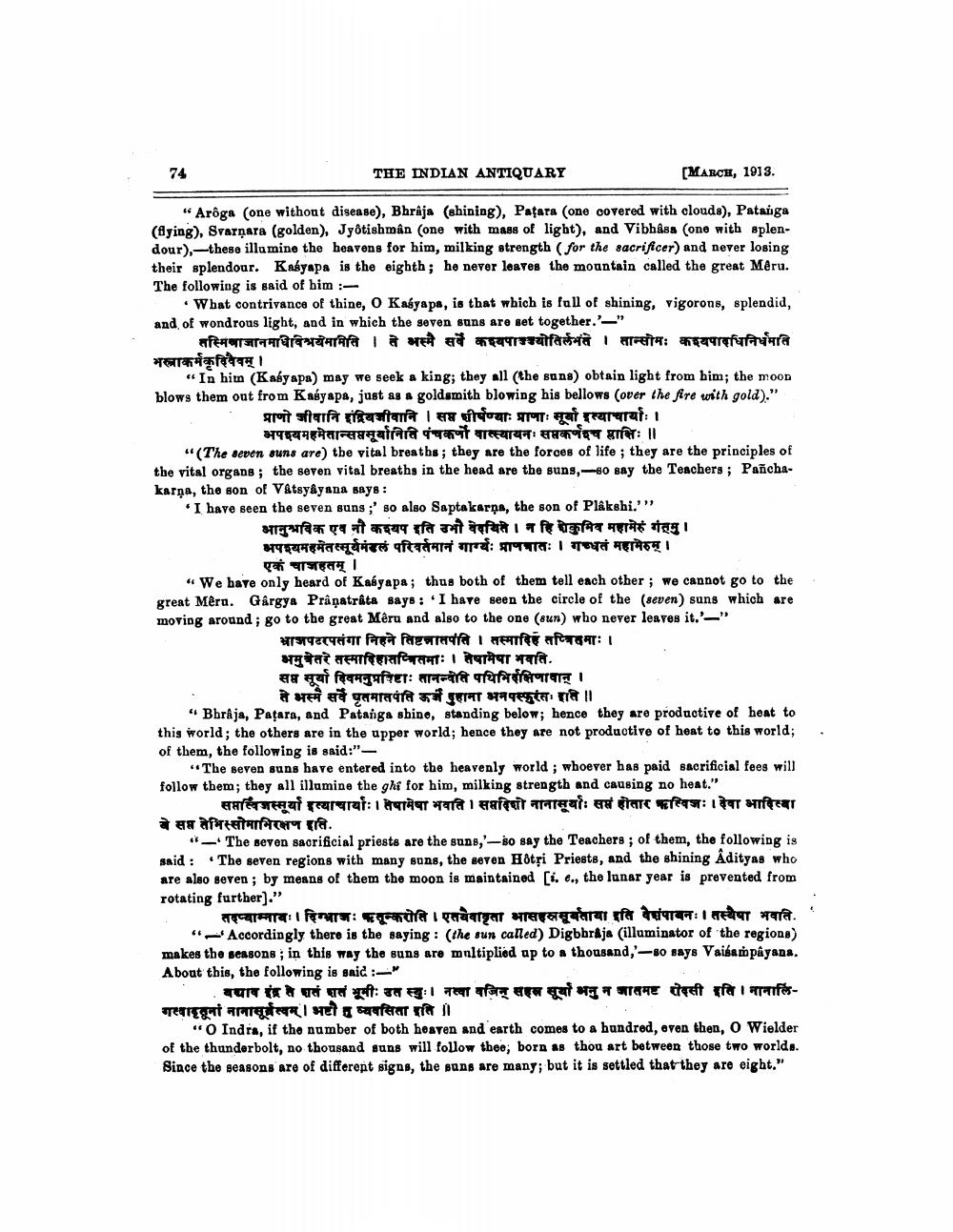________________
74
THE INDIAN ANTIQUARY
[MARCH, 1913.
"Aroga (one without disease), Bhraja (shining), Patara (one covered with clouds), Patauga (Bying), Svarnara (golden), Jyotishmin (one with mass of light), and Vibhasa (one with splendour),-these illamine the heavens for him, milking strength (for the sacrificer) and never losing their splendour. Kabyapa is the eighth; he never leaves the mountain called the great Mêru. The following is said of bim :
What contrivance of thine, O Kaśyapa, is that which is full of shining, vigorons, splendid, and of wondrous light, and in which the seven suns are net together.'-"
तस्मिवाजानमाधविश्रयमामिति । ते अस्मै सर्वे कश्वपाग्ज्योतिर्लभते । सान्सोमः कश्यपावधिनिर्धमति भस्त्राकर्मकृविवैवम् ।
"In hitn (Kabyapa) may we seek a king; they all (the suns) obtain light from him; the moon blows them out from Kayapa, just as a goldsmith blowing his bellows (over the fire with gold)."
प्राणो जीवानि इंद्रियजीवानि | सप्त शीर्षण्याः प्राणाः सूर्या इत्याचार्याः ।
भपश्यमहमेसान्सप्तसूर्यानिति पंचकों वात्स्यायनः सप्तकर्णश्च प्राक्षिः॥ "(The seven suns are) the vital breaths; they are the forces of life; they are the principles of the vital organs; the seven vital breaths in the head are the suns,-50 say the Teachers ; Panchakarna, the son of Vatsyāyana says: •I have seen the seven suns%3; so also Saptakarpa, the son of Plakshi.''"
भानुभविक एव नौ कश्यप इति उभौ वेदयिते । न हि कुमिव महामेरुं गतमु । भपश्यमहमेतत्सूर्यमंडलं परिवर्तमानं गायः प्राणघातः । गच्धतं महामेरुम् ।
एकंचाजहतम् । “We have only heard of Kabyapa; thus both of them tell each other; we cannot go to the great Mera. Gargya Prapatrata says: I have seen the circle of the (seven) suns which are moving around; go to the great Mêru and also to the one (sun) who never leaves it.'"
भाजपटरपतंगा निहने तिष्टनातपति । तस्मादिह तखितमाः । भमुखेतरे तस्मादिहातबिसमाः । तेषामेषा भवति.. सप्त सूर्या दिवमनुपरिटाः तानन्वति पथिमिक्षिणावान् ।
ते भस्म सवे घृतमातपंति ऊर्जबुहामा भनपस्फुरंतःहति।। " Bhraja, Patara, and Patanga shine, standing below; hence they are productive of heat to this world; the others are in the upper world; hence they are not productive of heat to this world; of them, the following is said:"
"The seven suns have entered into the heavenly world; whoever has paid sacrificial fees will follow them; they all illamine the ghi for him, milking strength and causing no heat."
सप्तर्विजस्सूर्या त्याचार्याः। तेषामेषा भवति। सप्तदिशो नानासर्याः सप्त होतार कस्विजः । देवा भाविस्था बे सप्त तेभिस्सोमाभिरक्षण इति.
"- The seven sacrificial priests are the suns-Bo say the Teachers 3 of them, the following is said: • The seven regions with many sons, the seven Hôtři Priests, and the shining Adityas who are also seven ; by means of them the moon is maintained [i. e., the lunar year is prevented from rotating further)."
तत्याम्नावः । दिग्धाजःकतन्करोति । एतवेवावृता भासहस्रसूतावा इति पेशंपावनः। तस्यैषा भवति. "-Accordingly there is the saying: (the sun called) Digbhraja (illuminator of the regions) makes the seasons ; in this way the suns are multiplied ap to a thousand,'---80 says Vaibampâyans. About this, the following is said:-.
बचाव द्रले पातं पातं भूमी उत स्युः। नवा वजिन् सहन सूर्यो भनुन जातमष्ट रोवसी रति । नानालिगवाहतूनां नानासूर्वस्वम् । भष्टी तुष्यवसिता इति ॥
"o Indra, it the number of both heaven and earth comes to a hundred, even then,OWielder of the thunderbolt, no thousand suns will follow thee; born as thou art between those two worlds. Since the seasons are of different signs, the suns are many; but it is settled that they are eight."




